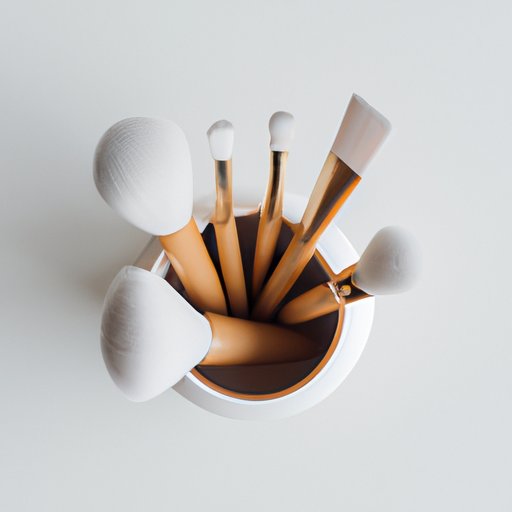
Your Ultimate Guide to Properly Washing and Maintaining Your Makeup Brushes
Makeup has become an essential part of our daily routine, and brushes are one of the primary tools for achieving a flawless look. However, not cleaning these brushes can lead to acne and other skin problems. Properly washing and maintaining your makeup brushes is crucial for keeping them germ-free and in excellent condition. In this article, we’ll provide you with a complete guide on how to clean and maintain your makeup brushes, from eco-friendly cleaning solutions to expert tips.
A Step-by-Step Guide to Cleaning Your Makeup Brushes Like a Pro
Before you start cleaning your makeup brushes, prepare the necessary tools and materials, including a brush cleaner, clean water, a bowl, and a clean towel. Now, let’s get started:
- Organize your dirty brushes and place them in the bowl.
- Wet the bristles with lukewarm water, taking care not to soak the brush handle as it can loosen the glue that holds the bristles in place.
- Apply a small amount of brush cleaner to the bristles.
- Gently swirl the brush in the bowl, rubbing the bristles against your palm to release the makeup. Repeat this step until the water runs clear.
- Rinse the bristles thoroughly using clean water.
- Wipe the bristles gently with a clean towel to remove excess water and reshape them.
- Place the brushes flat on a clean towel to air dry them. Avoid drying them vertically as water can seep into the handle and loosen the glue.
Depending on their use, we recommend washing your makeup brushes at least once a week or whenever you see the buildup of makeup. Frequent cleaning not only ensures the removal of bacteria but also increases the longevity of your brushes.
The Expert’s Take: Tips for Keeping Your Makeup Brushes Germ-Free
Now that you know how to clean your makeup brushes let’s dive into expert tips to keep your brushes germ-free:
- Tip #1: Invest in high-quality brushes that are easier to clean and maintain.
- Tip #2: Stay away from oil-based products as they can be challenging to remove from your brush bristles.
- Tip #3: Use a makeup brush-specific cleaner to ensure you’re using a product that’s safe for your face and your brush bristles.
- Tip #4: Avoid leaving your brushes on surfaces or in close proximity to other products. Keep them in a clean, dry area.
- Tip #5: Take care when washing your brushes to ensure you’re not damaging the bristles or handle.
In addition to these tips, it’s essential to know that cleaning your makeup brushes doesn’t have to be an expensive or complicated process. There are several products, including soaps and shampoos, that you can use to clean your brushes effectively.
DIY Cleansing Solutions for Sparkling Clean Makeup Brushes
If you’re looking for a more natural alternative to traditional makeup brush cleaners, we have you covered. You can use these homemade cleaning solutions for a deep cleanse:
- Olive oil: Mix olive oil and dishwashing liquid to clean your brushes.
- Baby shampoo: Mix a tablespoon of baby shampoo with a cup of lukewarm water and use the solution to clean your brushes.
- Vinegar: Mix two teaspoons of vinegar with a cup of lukewarm water. Dip the brushes into the solution and rinse with clean water.
- Baking soda: Mix equal parts of baking soda and water to create a paste. Apply the paste to your brushes, scrub gently, then rinse with lukewarm water.
- Castile soap: Combine Castile soap with warm water and use this mixture to clean your brushes.
Not only are these DIY solutions eco-friendly, but they’re also affordable and natural, making them great for your brushes and your skin.
Eco-Friendly Makeup Brush Cleaning: Do it the Green Way
Most traditional chemical-based cleaning solutions can harm the environment. Fortunately, there are a variety of eco-friendly cleaning solutions that are safe and proven effective.
- Lemon and baking soda: Mix a tablespoon of baking soda, lemon, and water to make a paste. Dip your brush in the paste and rinse it under running water.
- Tea tree oil: Dilute two drops of tea tree oil in a cup of water and use the solution to clean your brushes. Tea tree oil is known for its antibacterial properties and can leave your brushes smelling great.
- Alcohol: Mix alcohol and witch hazel in a ratio of 1:1. Use this solution to clean your brushes, then let them air dry.
Using eco-friendly cleaning solutions can help protect the planet while keeping your makeup brushes clean and germ-free. Make sure to dispose of the remaining solutions properly to minimize their impact on the environment.
Why You Need to Clean Your Makeup Brushes & How Often You Should Do It
Dirty makeup brushes can cause breakouts, skin irritation, and allergic reactions. Over time, bacteria and germs can buildup, making your brushes less effective and deteriorating their quality.
To avoid these issues, clean your makeup brushes at least once every two weeks or whenever you notice makeup buildup. Brushes that are used for liquid or cream products should be washed more frequently, while brushes used for powder products can go longer between cleanings.
After cleaning your makeup brushes, store them in an area free from dust and moisture. Storing them in open-air containers can also help keep bacteria and germs at bay.
Conclusion
Properly cleaning and maintaining your makeup brushes is essential for keeping them in excellent condition and free from bacteria and germs. You don’t need costly products to effectively clean your brushes; simple household items like olive oil, dishwashing liquid, and vinegar can be used as effective cleaning solutions. Additionally, using eco-friendly solutions can help protect both your skin and the planet. Remember to regularly clean your makeup brushes for a flawless makeup application every time.





